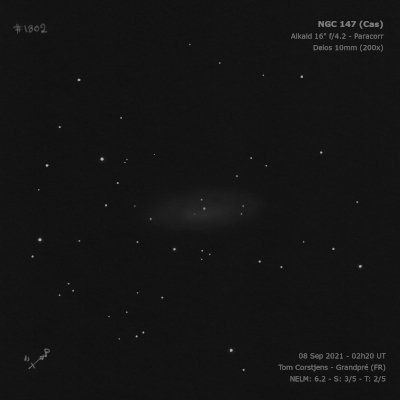
I first identified two mag 13 stars at 1' separation oriented N-S, which are situated 5' SSE of the center of NGC 147. These stars are just outside the halo of the galaxy. A mag 14.7 star is 1' further NW, forming an obtuse isosceles triangle with the two mag 13 stars. Hodge 3 is 41" N of the mag 14.7 star and nearly forms the 4th vertex of a parallelogram with these three stars.
John Herschel discovered NGC 147 = h29 on 8 Sep 1829 and recorded "vF; vL; irr R; 4..5' diam; loses itself insensibly; has a *11m in the centre." Bindon Stoney, LdR's observer on 25 Oct 1851, logged "L, vF neby, round a * 12m. I suspect it is a spiral of the faintest class, perhaps h 29." On 21 Aug 1852, George J. Stoney wrote, "Involves some stars, one of about 12th or 13th magnitude, E; vF."
In 1944 William Baade announced that NGC 147, along with NGC 185, were members of the Local Group (1944ApJ...100..147B) when they were resolved into stars on plates take with the 100-inch at Mt Wilson. NGC 147 is considered a satellite system of M31 at a distance of 2.3 million light years.
200/250mm - 8" (8/28/81): very faint, moderately large, slightly elongated, diffuse.
400/500mm - 17.5" (10/13/90): fairly faint, very large, elongated almost 2:1 SSW-NNE, 5'x3', very low almost even surface brightness. A mag 13.8 foreground star is superimposed just north of center. The halo gradually fades into background.
17.5" (8/29/92): appears larger (8'x4') using 20mm Nagler in the White Mountains (elevation 12,500 ft).
600/800mm - 24" (1/1/16): Hodge III is the brightest globular cluster in NGC 147 at V ≈ 16.5. At 450x and 500x it only occasionally popped but was verified at the same position using a detailed finder chart.
Notes by Steve Gottlieb